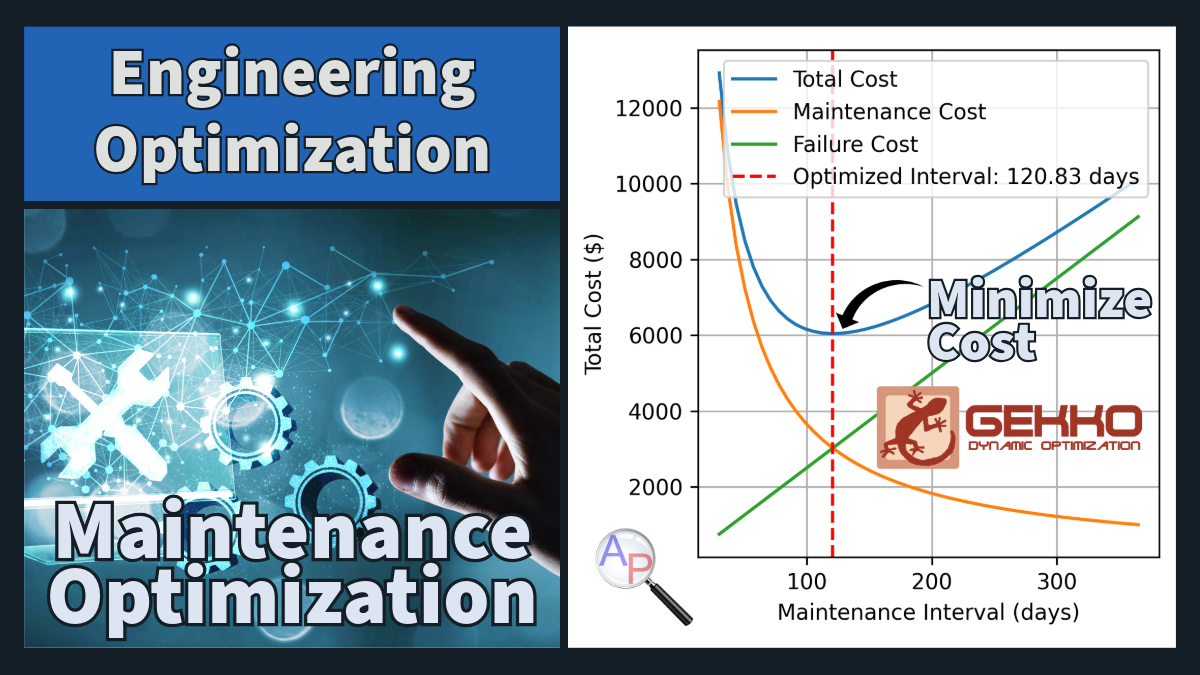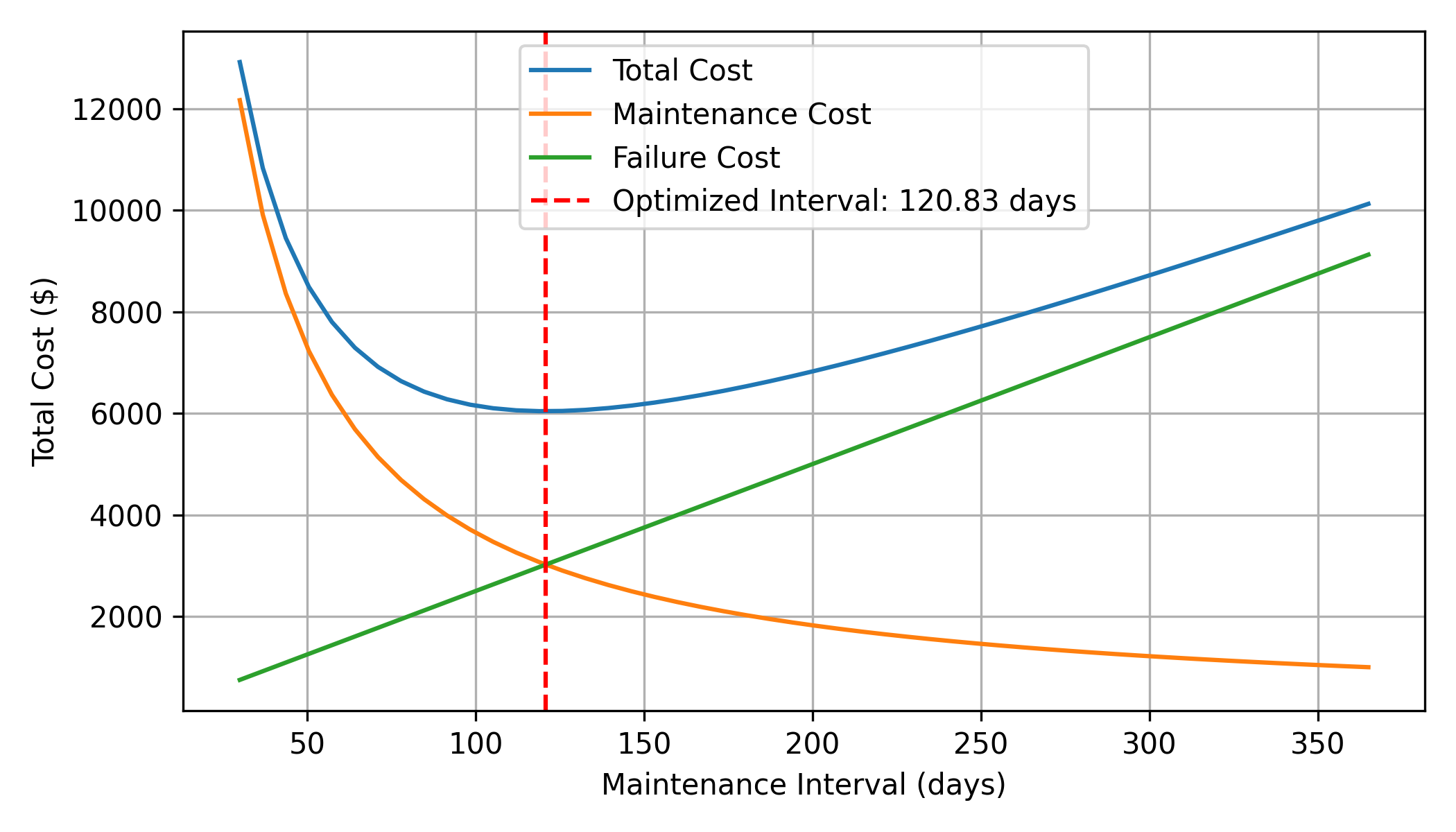Maintenance Interval Optimization

Python Gekko optimization package determines the optimal maintenance intervals in a manufacturing facility to minimize total operational costs. The costs include maintenance costs and failure-related costs when equipment is not maintained on time. The optimization balances between frequent maintenance and reducing downtime due to equipment failure.
Import Libraries: Import the necessary libraries for Gekko and plotting. Install Gekko if not already installed.
import numpy as np
import matplotlib.pyplot as plt
# Initialize the Gekko model
m = GEKKO(remote=False)
Define Parameters: Set up the parameters for the model such as maintenance costs, failure rate, and failure costs.
failure_rate = m.Param(value=0.01) # Failure rate per day
cost_maintenance = m.Param(value=1000) # Cost per maintenance
cost_failure = m.Param(value=5000) # Cost per failure
Define Variables: The maintenance interval is the decision variable to be optimized.
interval = m.FV(value=90, lb=30, ub=365) # Maintenance interval (days)
interval.STATUS = 1 # Allow optimization
# Maintenance cost function: Periodic maintenance cost
maintenance_cost = m.Intermediate(cost_maintenance * (365 / interval))
# Failure cost function: Failures that happen if no maintenance
failures = m.Intermediate(failure_rate * (interval / 2)) # Average failures
failure_cost = m.Intermediate(cost_failure * failures)
# Total cost: Sum of maintenance cost and failure cost
total_cost = m.Var()
m.Equation(total_cost==maintenance_cost + failure_cost)
# Objective: Minimize the total cost
m.Minimize(total_cost)
Solve the Optimization Problem: Solve the optimization problem to find the optimal maintenance interval.
m.options.IMODE = 3 # Steady-state optimization
m.options.SOLVER = 1 # APOPT Solver
# Solve the optimization problem
m.solve(disp=True)
# Print optimized maintenance interval
opt = interval.value[0]
print(f"Optimized maintenance interval: {opt:.2f} days")
Results Visualization: Plot the cost breakdown to visualize the optimization result.
intervals = np.linspace(30, 365, 50)
total_costs = []
maintenance_costs = []
failure_costs = []
interval.STATUS = 0
for i in intervals:
interval.value = i
m.solve(disp=False) # Solve for each interval value
total_costs.append(total_cost.value[0])
maintenance_costs.append(maintenance_cost.value[0])
failure_costs.append(failure_cost.value[0])
# Plot total cost vs. interval
plt.figure(figsize=(7, 4))
plt.plot(intervals, total_costs, label='Total Cost')
plt.plot(intervals, maintenance_costs, label='Maintenance Cost')
plt.plot(intervals, failure_costs, label='Failure Cost')
plt.axvline(opt, color='red', linestyle='--',
label=f'Optimized Interval: {opt:.2f} days')
plt.xlabel('Maintenance Interval (days)')
plt.ylabel('Total Cost ($)')
plt.legend(); plt.grid(True)
plt.savefig('total_cost_vs_interval.png', dpi=300)
plt.show()

This example demonstrates how to use Gekko to optimize maintenance intervals, balancing the trade-offs between the costs of regular maintenance and potential downtime due to equipment failure. Adjust the parameters such as failure rates, costs, and intervals to fit different industrial scenarios. Turn-around events are much more complex and involve plant-wide maintenance planning during facility shut-down periods. Many maintenance activities are scheduled during those planned outages. For other equipment that doesn't require facility shutdown, regular maintenance schedules can be optimized to trade-off interval with cost of breakdown.
import numpy as np
import matplotlib.pyplot as plt
# Initialize the Gekko model
m = GEKKO(remote=True)
# Parameters
failure_rate = m.Param(value=0.01) # Failure rate per day
cost_maintenance = m.Param(value=1000) # Cost per maintenance
cost_failure = m.Param(value=5000) # Cost per failure
# Variables
interval = m.FV(value=90, lb=30, ub=365) # Maintenance interval (days)
interval.STATUS = 1 # Allow optimization
# Maintenance cost function: Periodic maintenance cost
maintenance_cost = m.Intermediate(cost_maintenance * (365 / interval))
# Failure cost function: Failures that happen if no maintenance
failures = m.Intermediate(failure_rate * (interval / 2)) # Average failures
failure_cost = m.Intermediate(cost_failure * failures)
# Total cost: Sum of maintenance cost and failure cost
total_cost = m.Var()
m.Equation(total_cost==maintenance_cost + failure_cost)
# Objective: Minimize the total cost
m.Minimize(total_cost)
# Set solver options
m.options.IMODE = 3 # Steady-state optimization
m.options.SOLVER = 1 # APOPT Solver
# Solve the optimization problem
m.solve(disp=True)
# Print optimized maintenance interval
opt = interval.value[0]
print(f"Optimized maintenance interval: {opt:.2f} days")
# Create an array of intervals to calculate total costs
intervals = np.linspace(30, 365, 50)
total_costs = []
maintenance_costs = []
failure_costs = []
interval.STATUS = 0
for i in intervals:
interval.value = i
m.solve(disp=False) # Solve for each interval value
total_costs.append(total_cost.value[0])
maintenance_costs.append(maintenance_cost.value[0])
failure_costs.append(failure_cost.value[0])
# Plot total cost vs. interval
plt.figure(figsize=(7, 4))
plt.plot(intervals, total_costs, label='Total Cost')
plt.plot(intervals, maintenance_costs, label='Maintenance Cost')
plt.plot(intervals, failure_costs, label='Failure Cost')
plt.axvline(opt, color='red', linestyle='--',
label=f'Optimized Interval: {opt:.2f} days')
plt.xlabel('Maintenance Interval (days)')
plt.ylabel('Total Cost ($)')
plt.legend(); plt.grid(True)
plt.tight_layout()
plt.savefig('total_cost_vs_interval.png', dpi=300)
plt.show()
More examples can be found on the Gekko Documentation Page.
